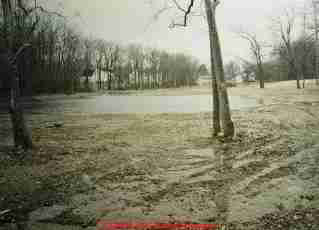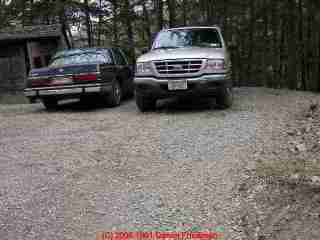 Home Buyer's & Seller's Guide to Septic Drainfield Failures
Home Buyer's & Seller's Guide to Septic Drainfield Failures
- POST a QUESTION or COMMENT about discovering a failed septic leach field or soakaway bed during the purchase of a home - what should a home buyer or home seller do about a failed drainfield?
Septic drainfield failure detection & actions when buying a home:
This article series discusses how to diagnose and repair Septic Drain Field Failures. We describe common causes of leachfield failures, and we give advice for home buyers or home sellers for the case when a septic failure is discovered during the home sale process.
This article series outlines what goes wrong with septic systems and their various components and describes septic inspection and test methods in detail, explains how to be sure your septic inspection and septic test are conducted properly, tells you where to get more septic system information about a given property, and warns of unsanitary or dangerous site conditions.
InspectAPedia tolerates no conflicts of interest. We have no relationship with advertisers, products, or services discussed at this website.
- Daniel Friedman, Publisher/Editor/Author - See WHO ARE WE?
Drainfield or Soakaway Bed Failures: Septic Leach Field Failures that Occur When Buying or Selling a Home
 Some septic system repairs are comparatively modest, such as replacing covers or baffles.
Some septic system repairs are comparatively modest, such as replacing covers or baffles.
Replacing septic tanks or leach fields is costly. No leach field has an infinite life, but proper septic system maintenance can defer this cost. Because costly septic system repairs may be upcoming, buyers of properties with a septic system are advised to inspect and test the system before purchase.
Clogged drainfield soils
[Click to enlarge any image]
The most common and normal drainfield end-of-life failure is clogging of the soils around the drainfield trench.
As we elaborate below, with time and age and normal drainfield functioning, a natural formation of a biomat around the drainfield trench ultimately leads to a thick slime layer that blocks wastewater passage into the surrounding soils.
But failure to pump the septic tank on schedule allows suspended solids and greases to flow into the drainfield, speeding up this clog-up process.
Pumping the septic tank on proper schedule and use of a septic filter are two steps that most add life to a conventional septic tank and drainfield design.
See details at SEPTIC TANK PUMPING SCHEDULE
and at FILTERS SEPTIC & GREYWATER
The sketch shows a conventional drainfield trench in cross section. As the drainfield line ages the soils become clogged
around the distribution piping, starting first at the end closest to the septic tank or distribution box.
Eventually
soils around the entire line are clogged with a thick biomat, or perhaps worse, by grease or salts that should have
stayed in the septic tank. At this point the soil absorption system stops absorbing effluent.
The soils around the leaching bed trenches have become clogged and
stop passing effluent. Sending grease and floating solids into the leach field hastens this failure.
The biomat which forms below and around the sides the leaching beds will eventually also become too solid and impacted, stopping soil absorption.
In this leach field photo effluent was appearing in the light colored
area where the homeowner had begun some exploratory digging in a soggy spot only to see her hole fill up rapidly with effluent.
In the building drains become sluggish, stop, or back up into the building (unsanitary), or effluent may appear
on the property surface when the absorption system can no longer function or where a pipe has become damaged.
Flooded Drainfield Soils
A septic drainfield that has become saturated for any reason is no longer functional. Saturated leachfield or soakaway bed soils mean that the wastewater effluent is not being treated by bacterial action and that unsanitary wastewater is being discharged into the environment.
Our photo (left) shows several drainfield failure troubles: flooding over the drainfield and a nearby lake.
Depending on soil conditions, land slope and shape, and perhaps other conditions, a saturated drainfield may not be immediately apparent, but this failure shows up in the following ways:
- Septic wastewater breaks out or appears at the ground surface on or near the drainfield during normal use of the system at any time, seasonally in wet weather or always or at irregular intervals
- Septic wastewater breaks out or appears at the ground surface on or near the drainfield during a properly-conducted septic loading and dye test
- Inspection reveals flooding in the D-box
- Inspection during septic tank pumpout reveals sewage wastewater flowing backwards from the drainfield into the septic tank
- Sewage odors in or around the drainfield area or possibly at the septic tank or D-box
- Abnormally high sewage levels in the septic tank, flooding over the tank baffles
- Sewage backup into the building or slow building drains
- See SEPTIC DRAINFIELD FAILURE DIAGNOSIS for details.
Building on or over or too close to the leach field causes failures
A leach field (or depending on where you live, drainfield, drainage bed, soakbed, soak pit, leach lines, septic trenches, or soil absorption system) that is supposed to absorb and treat septic effluent can be destroyed by other site "improvements" such as this attempt to install a swimming pool
atop the leaching area in the photo shown at left.
This mistaken installation involved multiple errors:
placing a pool atop the leaching area which prevents
proper oxygenation and evaporation, driving over the leach field which risks damaging buried pipes and compacting the soil, and excavating to
remove a portion of the absorption system soil to put in the swimming pool.
- Gray wastewater (laundry detergent) has appeared at the ground surface by an aboveground swimming pool
- A fool constructed the swimming pool right over part of the septic drainfield - driving equipment over the trenches (compacting soils or breaking piping), removed soil cover, and installed a pool over part of the drainfield surface, interfering with wastewater transpiration or evaporation. More on the mistake of building over the drainfield is provided below
The gray water you see next to the swimming pool in this larger photo was effluent from the failed septic fields.
Compacted Soil Drainfield Failures
Compacted soils due to parking or driving on the septic drainfield: driving over the leach field in any vehicle larger than a child's bicycle is a bad idea. Heavy vehicles may actually crush buried leach field lines, or they may compress the soils around the leach field, either of which leads to failure.
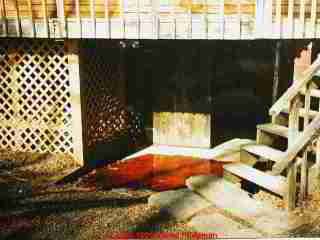
Driving
on or parking on leach fields will destroy them.
This property actually had no working septic system at all - 100% of its effluent was coming to the surface nearby, brought out by solid rock covered with shallow soils, and running down a steep hill into a local stream.
Paving over the leach field means not functional
A leach field cannot function properly if it is paved-over. Some folks may try this as a way
to permit parking over the absorption system.
But paving prevents both evaporation of effluent (a portion of the effluent disposal method) and it prevents oxygen from reaching the soil, thus inhibiting proper bacterial action needed to treat the effluent.
Question: D-box flooding indicates a septic field failure in house for sale, I can't afford a new drainfield. How to proceed?
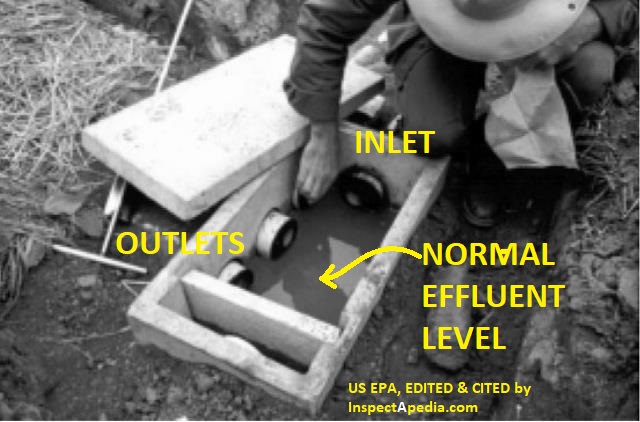 I am having a problem. I am listing my home for sale and had the septic checked out today. The septic company dug up and pumped out the tank with no problems being noticed. He then dug up the D box and inspected it.
I am having a problem. I am listing my home for sale and had the septic checked out today. The septic company dug up and pumped out the tank with no problems being noticed. He then dug up the D box and inspected it.
When he opened the lid system to the D box the water level was right up to the top of the box. He pumped out the D box and as he was doing that water (clear) was draining back into the D box from the field bed.
We have never had any problems with the septic system, we have it pumped every year since it was installed 18 years ago. The system has never backed up or over flowed on the lawn.
I did notice that the top of the septic tank is only 6" under ground and the top of the D box is 4.5 feet under ground. The distance from the center of the septic tank to the center of the D box is about 21 feet. If you do the math that would produce a 21" per foot pitch. ?
Correct me if I'm wrong but I thought it should only be 1/4 per foot pitch. Please help I cannot afford to install a complete new system. Thank You. - G. 6/19/12
Reply:
A competent onsite inspection by an expert usually finds additional clues that help accurately diagnose a problem with the septic system, piping, or drainfield. You are describing a flooded D-box and a flooded drainfield. .
That said, here are some things to consider:
- You've done the key septic maintenance step of pumping the septic tank - annual pumping may have been more often than needed, depending on tank size and number of home occupants but more frequent pumping never hurts the septic tank, just your wallet
- Water flowing back into the D-box from the fields, on an 18 year old system, is likely to indicate that the septic drainfield is saturated and in failure. But without some exploring we can't be completely sure that a simpler, less costly problem has occurred, such as a collapsed or blocked drainfield line or lines.
- There should be some pitch down from septic tank to D-box, though your system may be steeper than needed. Too-steep pitch in the actual drainfield trenches would be more serious, but too-steep pitch into the D-box can also cause septic system troubles.
The effects of a too-steep pitch of sewage effluent piping entering into the D-box can cause wastewater surging into the D-box and, if D-box exit pipes leave from the other three sides of the box, too much of the wastewater may charge straight across the box and into the drainfield line that is directly opposite the d-box entry port. This results in uneven distribution of wastewater and floods the center line. That's why pumped effluent systems often use a special D-box that includes baffles to assure that effluent is directed uniformly into the various exiting lines to various drainfield sections.
If you could look into the Distribution box again and tell me the configuration of the exit lines as well as the layout of the drainfield we could make more sense out of this point. It could be worthwhile, because if 1/3 of the field is doing all the work and is flooded it may be possible to improve the system by temporarily blocking off that drainfield section. More about the septic system distribution box or dbox is
at SEPTIC D-BOX INSTALL, LOCATE, REPAIR.
But if water flows into the D-box from all of the exiting lines, then the entire field is flooded and not working.
- Depending on soil conditions, porosity or percolation rates in the surrounding land, slope and land configuration, it is possible for a drainfield to be flooded without backing up into the septic tank and thence into the building. Instead, what's happening is that the flooding ground water or septic effluent mixed with ground water flows onward to other subsoil destinations (or in an ugly case, into nearby streams, waterways, even storm drains) without coming to the yard surface. So the septic system seems to be "working".
- And the drainfield is "working" in the sense that the system is "disposing" of septic effluent. But it is not working properly in that a flooded drainfield, because of lack of oxygen and perhaps bacterial action, will not be treating the effluent. The result is that pathogens from the wastewater are being discharged into the environment. Some may regard this as a technical objection since cesspools work the same way - they get rid of wastewater without treating it. But in most jurisdictions, such a system would not be approved by current sanitary codes.
- An additional step in investigating the drainfield would be some modest excavation to expose the very ends of each drainfield trench to see which trenches are flooded. I prefer to do this exploration by hand because bringing in a backhoe (preferred by excavators and septic contractors) is expensive, and it ruins the drainfield if it drives over it.
- Details about septic drainfield, leachfield, or soakaway bed failure are at
SEPTIC DRAINFIELD FAILURE DIAGNOSIS
SEPTIC DRAINFIELD LIFE
SEPTIC DRAINFIELD LOCATION
How to Avoid a Dispute Between Home Seller & Home Buyer over Septic System Failure
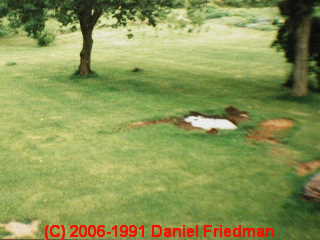 As a home seller, even hating the possible expense and trouble of septic repairs when moving, I would stay away from any cheap magic bullet "repairs".
As a home seller, even hating the possible expense and trouble of septic repairs when moving, I would stay away from any cheap magic bullet "repairs".
Like many troublesome and expensive "repairs", septic drainfield or soakaway bed failures lead to a whole industry of magic bullets, most of which do not work at all, the remainder work only temporarily or risk contaminating the environment, and/or are unsupported by impartial expert studies that confirm that the expense produces a lasting repair.
The risk is not only that your magic bullet money is wasted, but more, that you are asking for a later lawsuit by the new owner who will be furious to feel fooled into thinking they were buying a home that was not facing a near term significant expense to replace the drainfield.
See SEPTIC DRAINFIELD RESTORERS? for details.
As a home seller I would also stay away from simply finding some fool who is willing to certify that the septic system is functional and does not face a major repair. That too is inviting dispute later when the failure manifests itself and/or the new owner discovers that they face a very costly surprise. Our photo (above left) shows a drainfield failure discovered by a home buyer the morning after moving into their new home. The result was an ugly lawsuit.
Further Exploration Guides What to do About an Apparent Drainfield Failure
If further exploration confirms that we're not facing a blocked pipe (that can be repaired at much lower cost than a whole drainfield), and that drainfield replacement is needed, it would not be a surprise, nor abnormal for an 18-year old field.
You said you cannot afford to install a complete new system. When selling a home, if your attorney agrees, as I expect s/he would, that a seller is obligated to deliver a functional septic system, that does not mean that you personally have to pay for the repairs - the repair can be paid for out of proceeds of the sale of the home.
Attorney, contractor, buyer, and seller can work out an escrow or other means to handle that obligation. The wrinkle is that the buyer's bank often won't issue a mortgage for a property without a working septic system. A solution can be a temporary construction loan paid for out of escrow or house sale proceeds.
Leachfield Soakbed Failure Research
...
Continue reading at SEPTIC TROUBLE SIGNS, OTHER or select a topic from the closely-related articles below, or see the complete ARTICLE INDEX.
Or see these
Recommended Articles
- HOME BUYERS GUIDE to SEPTIC SYSTEMS
- HOME SELLERS GUIDE TO SEPTIC INSPECT
- SEPTIC TROUBLE SIGNS, OTHER
- SEPTIC DISPOSAL FIELD CLOGGING INSPECTION
- SEPTIC LOADING & DYE TEST PROCEDURE - home
Suggested citation for this web page
SEPTIC LEACH FIELD FAILURES at InspectApedia.com - online encyclopedia of building & environmental inspection, testing, diagnosis, repair, & problem prevention advice.
Or see this
INDEX to RELATED ARTICLES: ARTICLE INDEX to SEPTIC SYSTEMS
Or use the SEARCH BOX found below to Ask a Question or Search InspectApedia
Ask a Question or Search InspectApedia
Questions & answers or comments about discovering a failed septic leach field or soakaway bed during the purchase of a home - what should a home buyer or home seller do about a failed drainfield?
Try the search box just below, or if you prefer, post a question or comment in the Comments box below and we will respond promptly.
Search the InspectApedia website
Note: appearance of your Comment below may be delayed: if your comment contains an image, photograph, web link, or text that looks to the software as if it might be a web link, your posting will appear after it has been approved by a moderator. Apologies for the delay.
Only one image can be added per comment but you can post as many comments, and therefore images, as you like.
You will not receive a notification when a response to your question has been posted.
Please bookmark this page to make it easy for you to check back for our response.
IF above you see "Comment Form is loading comments..." then COMMENT BOX - countable.ca / bawkbox.com IS NOT WORKING.
In any case you are welcome to send an email directly to us at InspectApedia.com at editor@inspectApedia.com
We'll reply to you directly. Please help us help you by noting, in your email, the URL of the InspectApedia page where you wanted to comment.
Citations & References
In addition to any citations in the article above, a full list is available on request.
- New York State Department of Health, APPENDIX 75-A WASTEWATER TREATMENT STANDARDS - INDIVIDUAL HOUSEHOLD SYSTEMS , [PDF] New York State Department of Health, 3 February 2010, retrieved 3/1/2010, original source: https://www.health.ny.gov/regulations/nycrr/title_10/part_75/appendix_75-a.htm
- "International Private Sewage Disposal Code," 1995, BOCA-708-799-2300, ICBO-310-699-0541, SBCCI 205-591-1853, available from those code associations.
- "Manual of Policy, Procedures, and Guidelines for Onsite Sewage Systems," Ontario Reg. 374/81, Part VII of the Environmental Protection Act (Canada), ISBN 0-7743-7303-2, Ministry of the Environment,135 St. Clair Ave. West, Toronto Ontario M4V 1P5 Canada $24. CDN.
- Manual of Septic Tank Practice, US Public Health Service's 1959.
- Water Wells and Septic Systems Handbook, R. Dodge Woodson. This book is in the upper price range, but is worth the cost for serious septic installers and designers.
Quoting Amazon: Each year, thousands upon thousands of Americans install water wells and septic systems on their properties. But with a maze of codes governing their use along with a host of design requirements that ensure their functionality where can someone turn for comprehensive, one-stop guidance? Enter the Water Wells and Septic Systems Handbook from McGraw-Hill.
Written in language any property owner can understand yet detailed enough for professionals and technical students this easy-to-use volume delivers the latest techniques and code requirements for designing, building, rehabilitating, and maintaining private water wells and septic systems. Bolstered by a wealth of informative charts, tables, and illustrations, this book delivers:
* Current construction, maintenance, and repair methods
* New International Private Sewage Disposal Code
* Up-to-date standards from the American Water Works Association
- Wells and Septic System, Alth, Max and Charlet, Rev. by S. Blackwell Duncan, $ 18.95; Tab Books 1992. We have found this text very useful for conventional well and septic systems design and maintenance --DF. Quoting an Amazon description:Here's all the information you need to build a well or septic system yourself - and save a lot of time, money, and frustration. S. Blackwell Duncan has thoroughly revised and updated this second edition of Wells and Septic Systems to conform to current codes and requirements. He also has expanded this national bestseller to include new material on well and septic installation, water storage and distribution, water treatment, ecological considerations, and septic systems for problem building sites.
- In addition to citations & references found in this article, see the research citations given at the end of the related articles found at our suggested
CONTINUE READING or RECOMMENDED ARTICLES.
- Carson, Dunlop & Associates Ltd., 120 Carlton Street Suite 407, Toronto ON M5A 4K2. Tel: (416) 964-9415 1-800-268-7070 Email: info@carsondunlop.com. Alan Carson is a past president of ASHI, the American Society of Home Inspectors.
Thanks to Alan Carson and Bob Dunlop, for permission for InspectAPedia to use text excerpts from The HOME REFERENCE BOOK - the Encyclopedia of Homes and to use illustrations from The ILLUSTRATED HOME .
Carson Dunlop Associates provides extensive home inspection education and report writing material. In gratitude we provide links to tsome Carson Dunlop Associates products and services.


